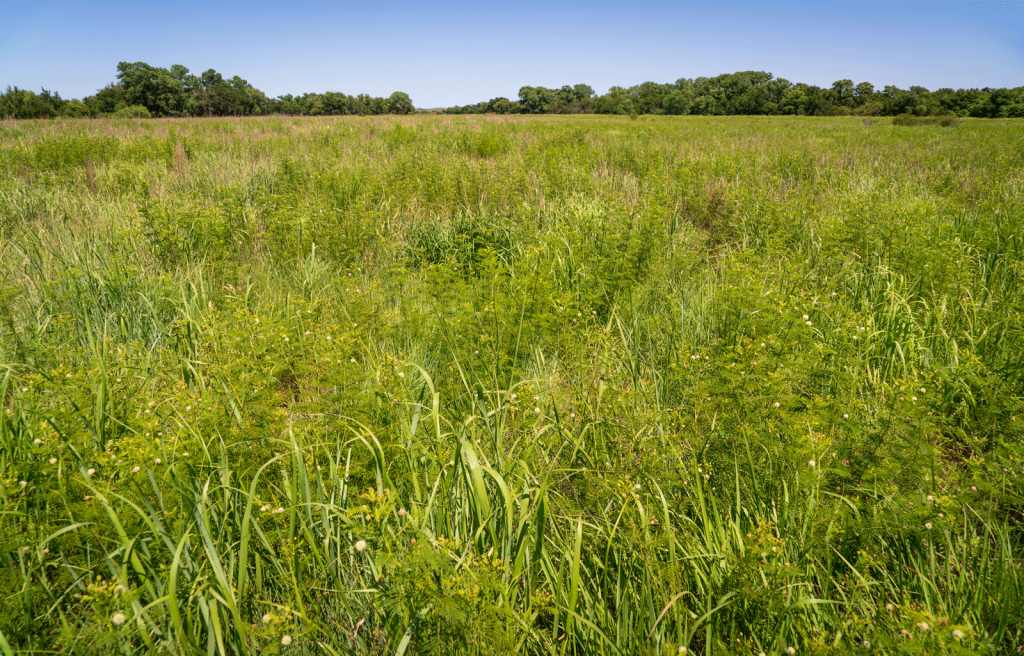
An overview of CRP mid-contract management requirements and strategies to maintain compliance while enhancing habitat quality.
When you enroll in a Conservation Reserve Program (CRP) contract, the commitment doesn’t end once your native grasses and forbs are in the ground. Ongoing stewardship is essential to maintain the environmental benefits of your project, and that’s where mid-contract management (MCM) comes in.
At All Native Seed, we often help landowners not only get started with CRP but also stay on track throughout their contract term. Understanding your mid-contract obligations is key to maintaining compliance and ensuring your land remains a thriving, healthy habitat.
What Is Mid-Contract Management (MCM)?
Mid-contract management refers to the required conservation activities that must be carried out between years 3 and 6 of most CRP contracts. These activities are designed to:
- Prevent your CRP field from becoming overgrown or dominated by a single species
- Enhance plant diversity and wildlife habitat
- Improve the long-term ecological function of the site
These are not optional add-ons, they are required for maintaining eligibility for CRP payments.
Why MCM Matters
Without proper intervention, even well-established CRP plantings can decline over time. For example:
- Woody plants and invasive species may begin to encroach
- Dominant grasses can outcompete forbs, reducing pollinator habitat
- Habitat quality can diminish, reducing your field’s conservation value
MCM practices help reset the balance in your planting, rejuvenate native species, and keep your CRP stand aligned with its original conservation goals.
Common Mid-Contract Management Practices
The USDA and NRCS provide approved MCM practices tailored to your region and contract type. The most commonly approved activities include:
Prescribed Burning
Controlled burning mimics natural prairie fires, reducing woody encroachment and stimulating native plant growth. It’s especially effective at improving species diversity. Be sure to check with your local NRCS office and follow state burn permit guidelines.
Light Discing or Interseeding
Light tillage or disking creates soil disturbance that can suppress dominant grasses and encourage new forb growth. Interseeding native forbs afterward can further boost diversity.
Strip Mowing or Haying
Mowing one-third to one-half of the field (not all at once) helps manage dense vegetation and open up sunlight to native seedlings. It can also reduce dead plant litter that smothers growth.
Herbicide Application
Targeted spot-spraying may be approved to control invasive or noxious weeds that threaten your native plant community.
Note: These activities must follow NRCS guidelines, be approved in advance, and documented properly to qualify as compliant MCM.
MCM Compliance: What You Need to Do
To remain in compliance and continue receiving CRP payments:
- Consult your NRCS or FSA office
Every contract has different requirements. Before beginning any mid-contract activity, confirm which practices are authorized for your field.
- Create a Mid-Contract Management Plan
Document the activities you intend to perform, including timing, methods, and target goals. Your NRCS office will help create this plan.
- Perform MCM activities during the designated window
Mid-contract practices must be carried out during approved dates, typically outside the primary nesting season.
- Keep detailed records
Save invoices, photos, maps, and any documentation showing what was done. This will be important for verification and USDA reimbursement.
How All Native Seed Can Help
At All Native Seed, we know the importance of proactive planning and native diversity in every phase of your CRP project. We can assist with:
- CRP-compliant seed mixes for interseeding after discing or disturbance
- Guidance on selecting species that will enhance diversity and habitat value
- Support working with FDCE (our parent company) for site prep or management services
We’re here to help you not just meet MCM requirements, but use them as a strategic opportunity to improve the long-term success of your project.
Final Thoughts: MCM as a Long-Term Investment
While it may feel like a chore, mid-contract management is a valuable investment in the health and longevity of your CRP planting. Done right, it will:
- Increase biodiversity
- Improve pollinator and wildlife habitat
- Strengthen native plant resilience
- Keep your project compliant with USDA regulations
Need help selecting the right native seed or planning your mid-contract strategy?
Contact All Native Seed today and let our team support your CRP success from planting to management and beyond.
